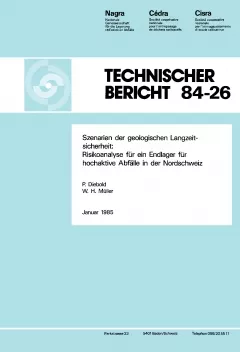
Technischer Bericht NTB 84-26
Szenarien der geologischen Langzeitsicherheit:Risikoanalyse für ein Endlager für hochaktive Abfälle in der Nordschweiz
A synopsis is presented of the geological risk factors for a high level radioactive waste repository in Northern Switzerland. The study is based on results available so far of the ongoing regional geological and neotectonic investigations.
Scenarios of possible future geological situations have been derived by combining data of observed and/or measured ongoing neotectonic processes with those of reconstructed trends of past geological history. These scenarios have been used to predict the impact of possible future geological developments and events on a repository for a time horizon of approx. one million years.
Two regional scenarios provide the framework for the megatectonic development:
- In scenario A the alpine orogenic cycle is assumed to have come to an end, tectonic movements would gradually die out. In such a scenario the safety of a repository within the Basement at a depth of some 1200 m is not considered to be at risk.
- For scenario B the alpine orogeny ist assumed to be actively continuing now and for the next 10 million years. Therefore, tectonic deformation in the Jura-mountains and the Black Forest would also continue. However, the results of the risk analysis indicate that plausible future geological developments within the timeframe of one million years would not adversely affect the safety of a repository.
As a result of major climatic changes, modifications to the surface stream pattern, erosion and/or denudation could severely affect the flow regime of shallow groundwater in sedimentary aquifers~ however, within the Basement such effects would be attenuated.
As a result of further Basement uplift in the Black Forest area and a simultaneous subsidence of the erosional baselevel glacial and river erosion could reach 200 m in the repository area.
Anticipated differential fault movements in the repository area would be manifested by the continued reactivation of preexisting zones of weakness. These movements would be caused by the continuing uplift in the southern Black Forest (Feldberg) area which is estimated to rise some 400 m during the next one million years.
It has been assumed that some 50 % of this total differential uplift would take place along known major fault zones. The remainder of some 200 m would result in a tilt in the repository area of approx. 7 m per km and one million years. This differential movements would cause a number of minor preexisting faults also within the repository to show shear movements estimated at some 50 cm each.
Potentially hazardous events such as the impact of meteorites, damage due to earth quakes, the intrusion of magma and volcanism have been dealt with in the report. However, these events present only a negligable risk due to the very low probability of occurrence.
